This is it. Our guide to the best lenses for astrophotography, updated for 2021. These are our favorite lenses for almost every interchangeable lens camera system available today. We’ve compiled our favorite 4 lenses for every camera system with options for any budget. If you’re looking for a great upgrade for your camera, a gift for your photographer friends or if you want to start building the best kit available for astrophotography on your current camera system, look no further than this list.
Introduction
I receive more questions about camera lenses than anything else. This guide (last updated June 2021) is for photographers looking for a distinct and tangible upgrade over the typical kit lens for their camera have a tremendous number of options from which to choose. For astrophotography, investment in a faster (lower f/number) lens will tend to show the most tangible benefits in image quality versus a camera body upgrade. Lens manufacturers have started listening to the demands of the rapidly growing number of astrophotography enthusiasts for sharp, low aberration lenses and many of the best lens choices for landscape astrophotography have been released in the last few years.
When I first made this list in 2017, we had significantly less options for astrophotography lenses. Now in 2021, things have absolutely exploded. Manufacturers have really stepped up their game when it comes to making great lenses for landscape astrophotography. Enough talk, here’s what we currently shoot with in our kit:
Fast Super Wide
The fast super wide angle is the workhorse lens for landscape composition. With fields-of-view exceeding 90 degrees from corner to corner, a super wide angle lens is the first recommendation that I suggest for most photographers looking to upgrade from their kit lens. The extra wide angle view helps tremendously with composition, especially when the plane of the Milky Way is high in the sky. Super wide angles range from about 8mm to 10mm on m4/3 cameras, 10mm to 14mm for APS-C cameras and 14mm to 20mm on full-frame cameras. Most super wide angle lenses that we recommend generally have an f/number of f/2.8 or lower and more recent designs are faster than f/2. Our personal choice for our camera bag is the amazing Sony FE 20mm f/1.8 G because it’s got a large aperture, it’s super wide and it’s relatively affordable. We also love shooting on our Zeiss Batis 18mm f/2.8.
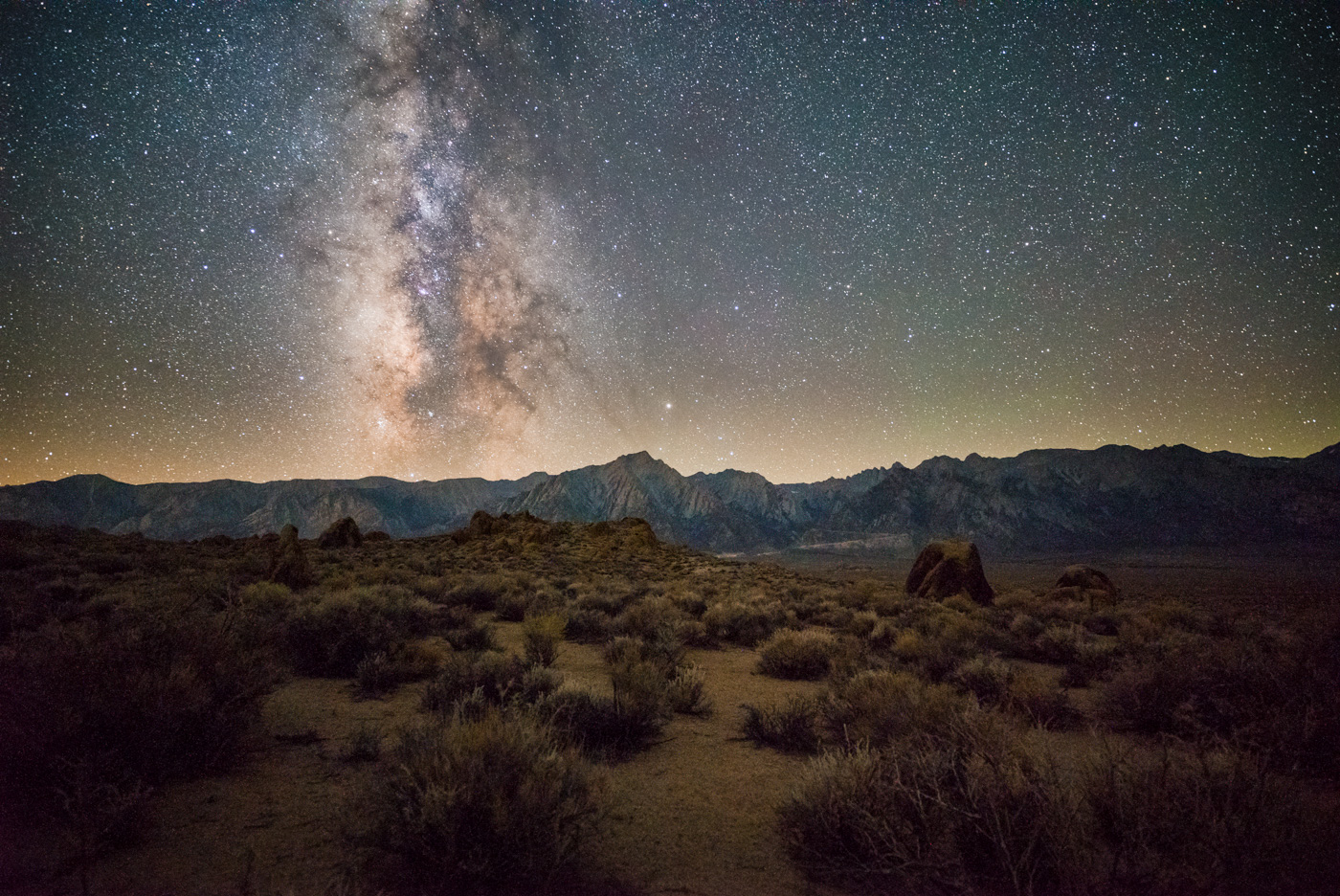
Fast Wide
A fast wide angle is the lens for pure low-light performance. With apertures of f/1.4 to f/2, a fast wide angle will gather two to eight times more light than the typical kit lens, making for the most tangible increase in image quality straight out of the camera. Use a fast wide angle to capture ultra low-noise landscapes. Fast wide angles range from about 12mm to 16mm on m4/3 cameras, 16mm to 24mm for APS-C cameras and 24mm to 35mm on full-frame cameras. Our favorite fast wide angle lenses in the camera bag are the Rokinon 24mm f/1.8 and 35mm f/1.8.
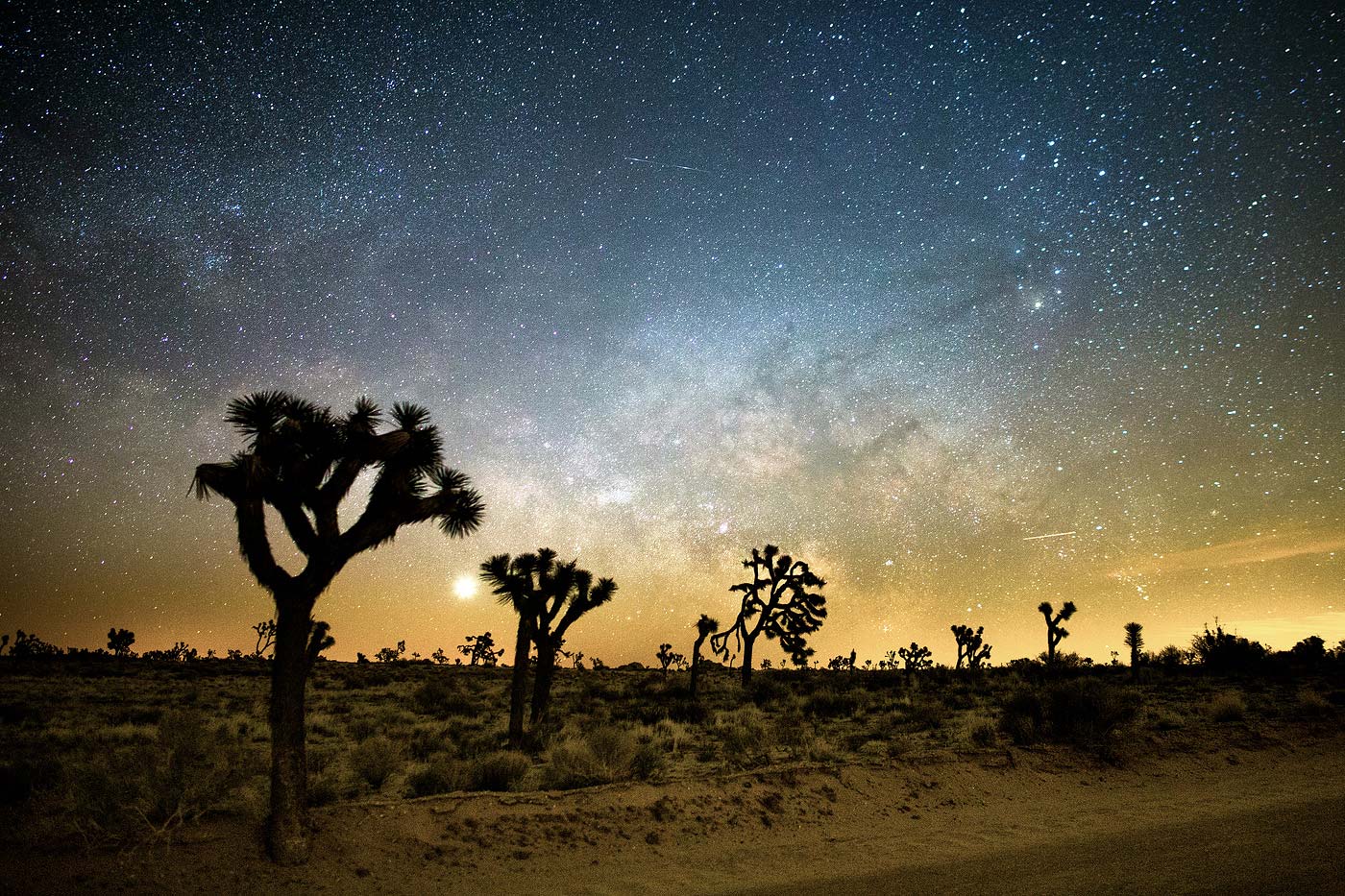
Standard Prime
The standard prime with a f/number of f/1.8 or lower is a recent addition to my recommended lenses for astrophotography. They have larger apertures when compared to most wide angle lenses. As a result, they gather more light, allowing them to capture even more fine detail in the night sky, even when stopped down to f/2.8. Their narrower field of view means that they can be used for making high resolution panorama stitches of the night sky. Panoramas require a more methodical workflow and more time post processing but they have become my personal favorite method for maximizing image quality in my astrophotography. Standard primes are roughly 25mm on m4/3 cameras, 35mm on APS-C cameras and 50mm on full-frame cameras. We use a Sony Zeiss FE 55mm f/1.8.
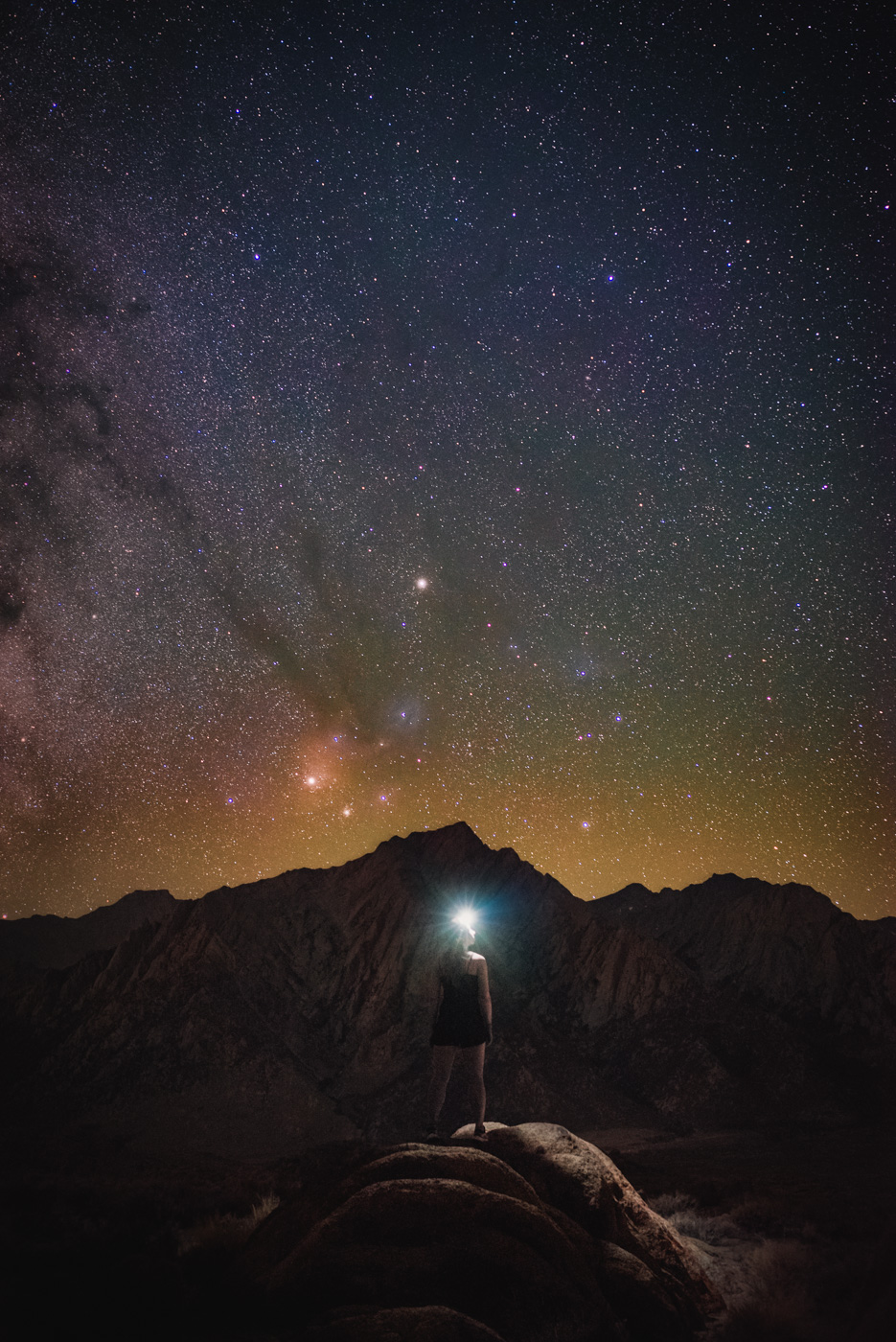
Sony FE Full-Frame
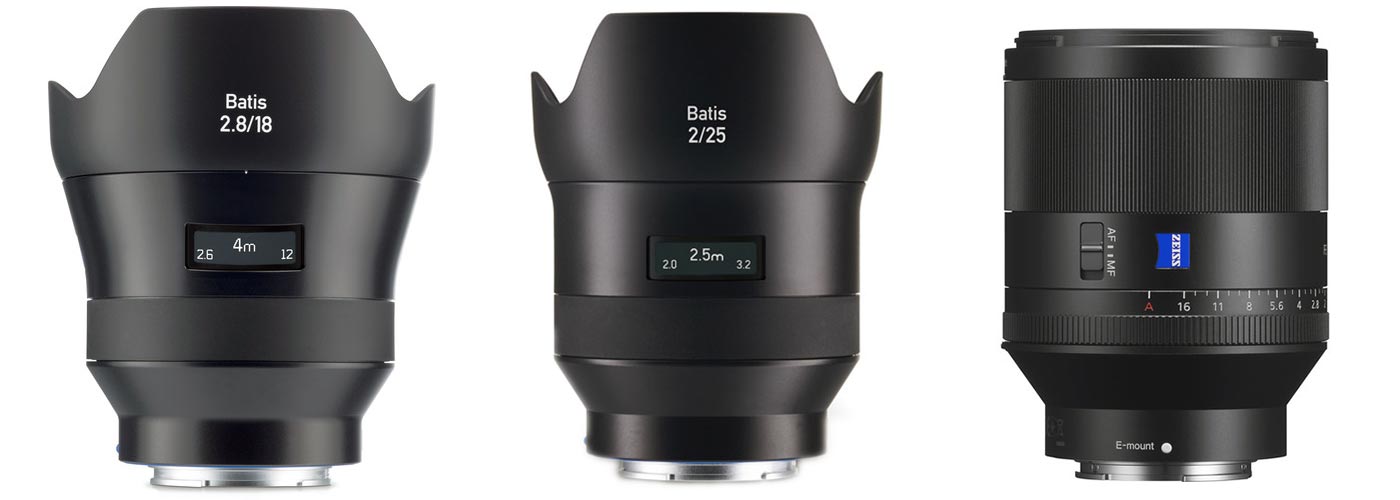
Super Wide Angle: Sony 14mm f/1.8 GM (B&H) or Sony 12-24mm f/2.8 GM or Zeiss Batis 18mm f/2.8 (Amazon / B&H)
Mid-Range: Sony 20mm f/1.8 (B&H)
Budget: Rokinon/Samyang 14mm f/2.8 or Rokinon/Samyang 18mm f/2.8
Fast Wide Angle: Sony 24mm f/1.4 GM (B&H) or Zeiss Batis 25mm f/2 (Amazon / B&H)
Budget: Sony FE 28mm f/2 (Amazon / B&H) or Rokinon/Samyang 24mm f/1.8
Standard Prime: Sony Planar T* FE 50mm f/1.4 ZA (Amazon / B&H)
Budget: Sony Zeiss 55mm f/1.8 (Amazon / B&H) or Rokinon 45mm f/1.8
Bargain: Sony FE 50mm f/1.8 (stopped to f/2.8) (Amazon / B&H)
The Sony a7 line of cameras as the first full-frame mirrorless camera system (other than a Leica) and is the most popular lens mount design on this list. I personally shoot with a Sony a7C and my wife uses a Sony a7III. Their latest cameras are my personal preference for astrophotography. Sony has been the leader in camera sensor technology in recent years and it shows in their cameras.
Sony has the most complete lens lineup of all mirrorless cameras. My personal favorite wide angle, and the lens that I keep on my camera about 90% of the time for landscape astrophotography is the Zeiss Batis 18mm f/2.8 (full review). I also personally use the Sony Zeiss 55mm f/1.8 (full review) as my standard prime. It’s one of the sharpest lenses I have ever used and it’s a perfect fit for astrophotography panoramas.
Canon RF
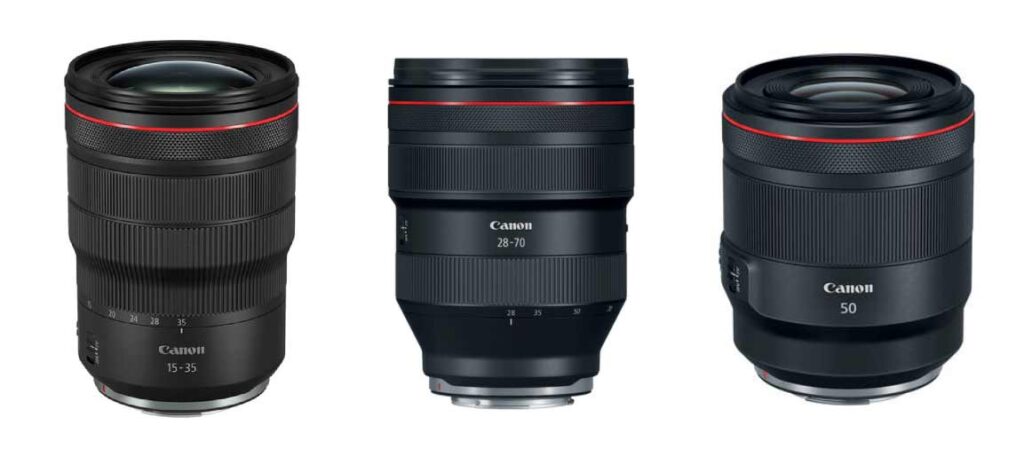
Super Wide Angle: Canon 15-35mm f/2.8L
Budget: Rokinon AF 14mm f/2.8 or Laowa 15mm f/2
Fast Wide Angle: Canon RF 28-70 f/2L
Standard Prime: Canon RF 50mm f/1.2L
Budget: Canon RF 50mm f/1.8
Canon’s new RF mount is quickly becoming much more complete with offerings for astrophotography. We absolutely loved shooting with the RF 50mm f/1.2 lens when we did our Canon EOS Ra review. The RF mount is still pretty new so fast wide angle lens options are fairly sparse. At the time of this writing, the only wide angle lens in the RF mount that’s faster than f/2.8 in the 24-35mm range is the RF 28-70 f/2L.
Nikon Z Full Frame
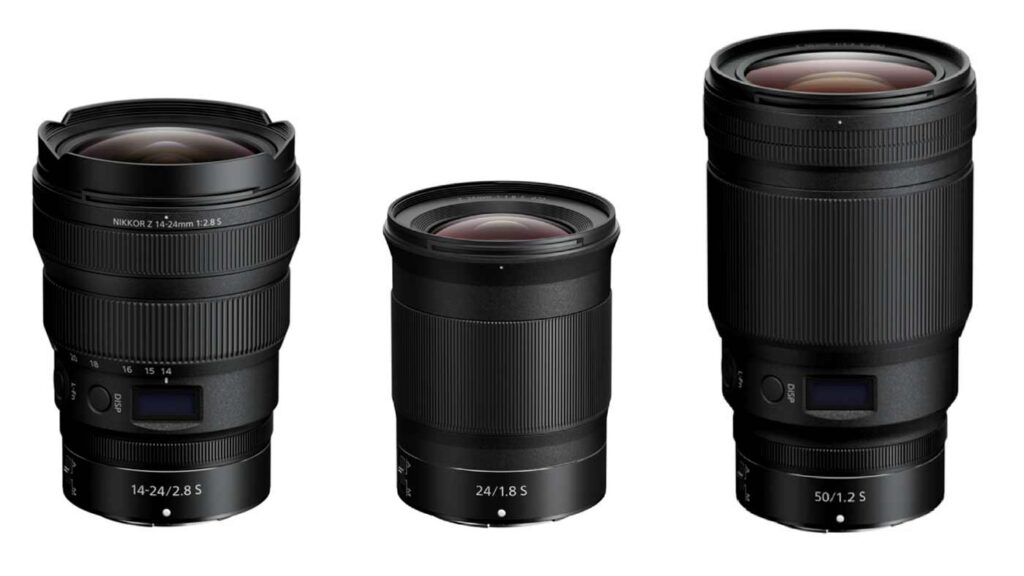
Super Wide Angle: Nikkor Z 14-24mm f/2.8 S or Z 20mm f/1.8 S
Mid-Range: Laowa 15mm f/2
Fast Wide Angle: Nikkor Z 24mm f/1.8 S
Standard Prime: Nikkor Z 50mm f/1.2 S
Mid-Range: Nikkor Z 50mm f/1.8 S
Nikon’s new Z mount is already filled out with some spectacular fast lens offerings for astrophotography, despite being very new alongside Canon’s RF mount. They luckily have a very affordable option for the fast wide angle category: the 24mm f/1.8 S is a perfect relatively compact lens choice for Z Full-Frame cameras. That said, some of their premium lens options like the 50mm f/1.2 and 14-24mm f/2.8 are quite large by comparison.
Sony E APS-C
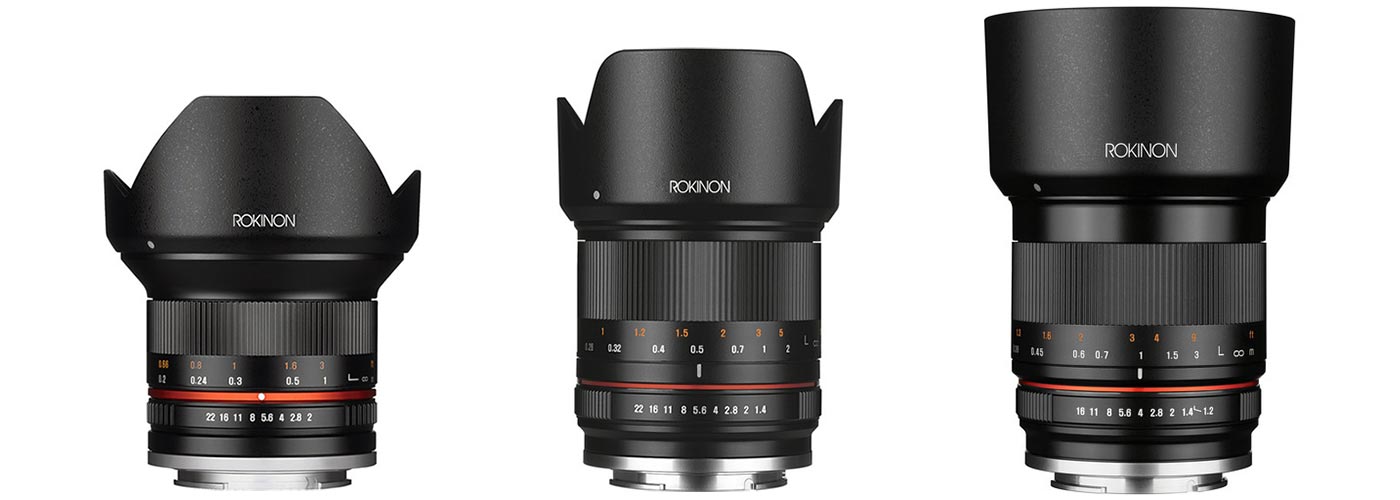
Super Wide Angle: Rokinon AF 12mm f/2 or Rokinon/Samyang 12mm f/2 Manual Focus(Amazon / B&H)
Fast Wide Angle: Rokinon/Samyang 24mm f/1.8 or Rokinon/Samyang 21mm f/1.4 (Amazon / B&H)
Standard Prime: Rokinon AF 35mm f/1.8 or Rokinon/Samyang 35mm f/1.2 (Amazon / B&H)
The Sony a6000 (full review) series and Sony’s other APS-C mirrorless cameras offer a ton of performance for the money. The a6000 is still my first recommendation for a great super budget choice for astrophotography. We prefer to pair these smaller mirrorless cameras with the compact mirrorless lens offerings from Rokinon/Samyang.
Canon EF Full-Frame
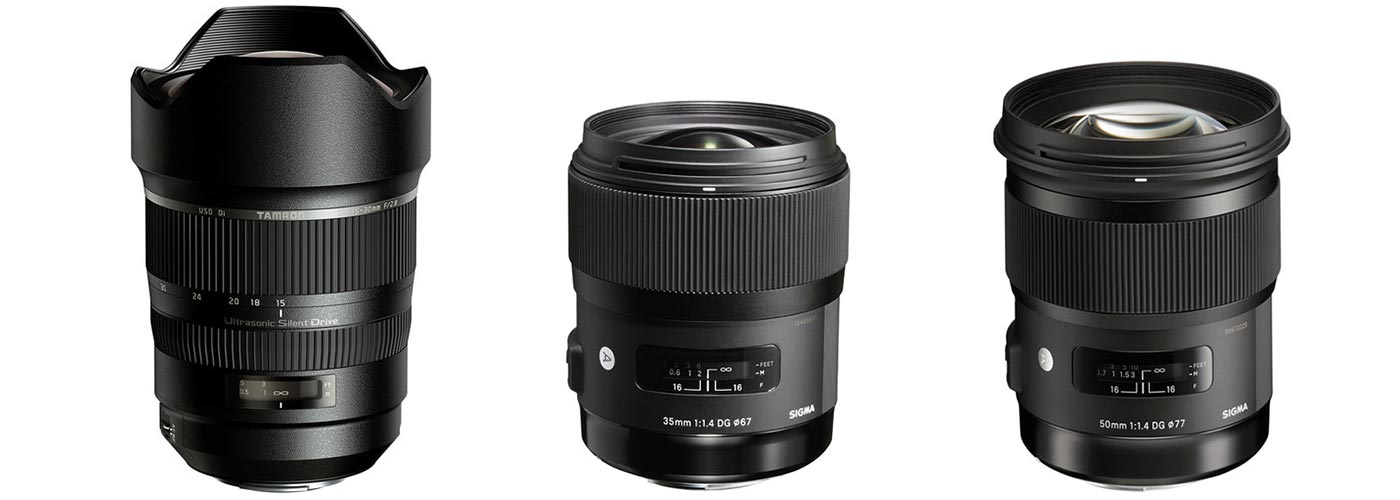
Super Wide Angle: Tamron 15-30mm f/2.8 (Amazon / B&H)
Mid-Range: Rokinon/Samyang 14mm f/2.4 SP (Amazon / B&H) or Rokinon/Samyang 20mm f/1.8 Amazon / B&H)
Budget: Rokinon/Samyang 14mm f/2.8 (Amazon / B&H)
Fast Wide Angle: Sigma 35mm f/1.4 Art (Amazon / B&H)
Budget: Rokinon/Samyang 24mm f/1.4 (Amazon / B&H) or 35mm f/1.4 (Amazon / B&H)
Standard Prime: Sigma 50mm f/1.4 Art (Amazon / B&H)
Budget: Tamron 45mm f/1.8 SP (Amazon / B&H)
Bargain: Canon EF 50mm F/1.8 STM (Stopped to f/2.8) (Amazon / B&H)
I started my photography career on Canon cameras and the EOS 6D (full review) still remains on my list of favorite DSLRs for astrophotography. Most of latest lens options from Tamron and Sigma have brought extremely high levels of performance for night photography to the system. The Tamron 15-30mm f/2.8 is unmatched for sharpness and a perfect choice for landscape astrophotography. For standard primes, don’t forget the extremely affordable Canon EF 50mm f/1.8 STM lens (full review). It’s not perfect wide-open at f/1.8 but it’s quite good when stopped down to f/2.8.
Canon EF-S APS-C
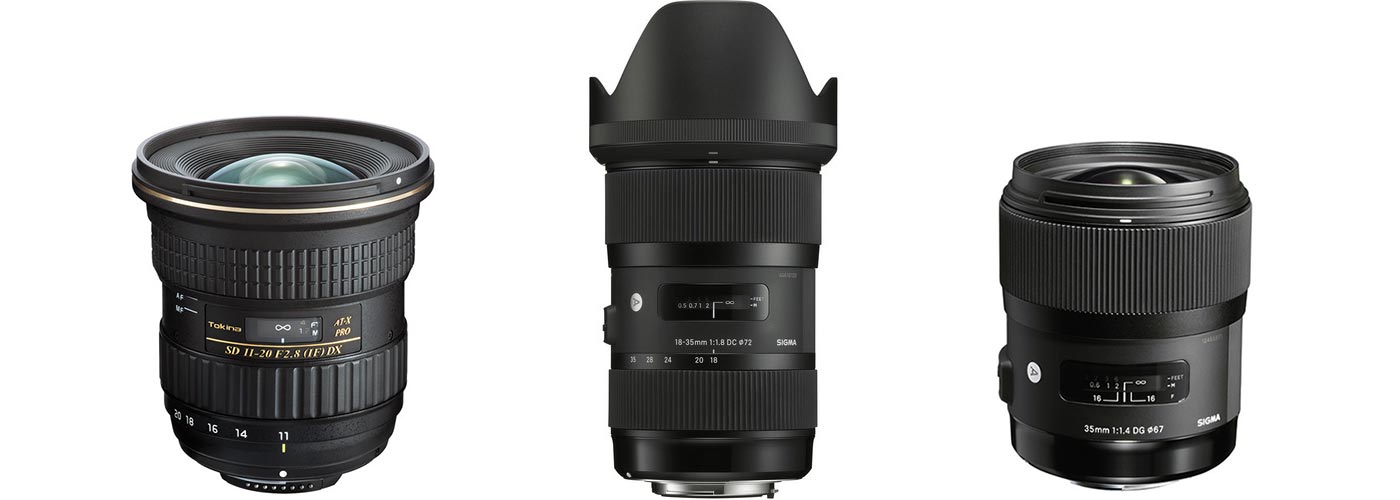
Super Wide Angle: Tokina 11-20mm f/2.8 (Amazon / B&H)
Budget: Rokinon 10mm/2.8 (Amazon / B&H)
Fast Wide Angle: Sigma 18-35mm f/1.8 Art (Amazon / B&H)
Budget: Rokinon/Samyang 16mm f/2.0 (Amazon / B&H)
Standard Prime: Sigma 35mm f/1.4 Art (Amazon / B&H)
Budget: Rokinon/Samyang 35mm f/1.4 (Amazon / B&H)
Canon’s APS-C DSLRs are still the best selling interchangeable lens cameras in the world. We still own a Canon EOS Rebel T5i (700D) and have shot astrophotography with it on occasion, even with the kit lens. In the realm of super wide angle, an excellent upgrade for Canon’s APS-C cameras is the excellent Tokina 11-20mm f/2.8 ultra-wide angle zoom. One stand out lens available for all APS-C DSLRs is the spectacular Sigma 18-35mm f/1.8. It’s the fastest standard zoom ever made and its performance for night photography is nearly perfect.
Canon EF-M APS-C

Super Wide Angle: Rokinon/Samyang 12mm f/2 (Amazon / B&H)
Fast Wide Angle: Rokinon/Samyang 21mm f/1.4 (Amazon / B&H)
Budget: Canon EF-M 22mm f/2 STM (Amazon / B&H)
Standard Prime: Rokinon/Samyang 35mm f/1.2 (B&H)
I had a generally positive experience shooting astrophotography with the original Canon EOS M (full review), even though that camera did not receive the best reviews around the community. I still think that the M line of cameras offer a lot of value for the money and are a good choice for photographers who want the familiarity of the excellent Canon interface. The EOS M line of cameras has become increasingly more competitive with other mirrorless cameras and all of our favorite APS-C mirrorless lenses, like the Rokinon 12mm f/2 (full review), are available for the new EF-M lens mount.
Nikon F FX Full-Frame

Super Wide Angle: Tamron 15-30mm f/2.8 (Amazon / B&H)
Mid-Range: Rokinon/Samyang 14mm f/2.4 SP (Amazon / B&H) or Rokinon/Samyang 20mm f/1.8 (Amazon / B&H)
Budget: Rokinon/Samyang 14mm f/2.8 (Amazon / B&H)
Fast Wide Angle: Sigma 35mm f/1.4 Art (Amazon / B&H)
Budget: Rokinon/Samyang 24mm f/1.4 (Amazon / B&H) or 35mm f/1.4 (Amazon / B&H)
Standard Prime: Sigma 50mm f/1.4 Art (Amazon / B&H)
Budget: Tamron 45mm f/1.8 SP (Amazon / B&H)
Bargain: Nikon 50mm f/1.8G (stopped to f/2.8) (Amazon / B&H)
Nikon’s full frame cameras like the D750 are a top choice for astrophotography. Nikon utilizes Sony’s excellent sensors in a classic DSLR body design that many photographers prefer over the more toy-like Sony camera bodies. Just like Canon’s full-frame mount, we love the lens offered from Tamron and Sigma. The Tamron 15-30mm f/2.8 is sharper and more affordable than Nikon’s already excellent 14-24mm f/2.8 and Sigma’s 35mm and 50mm Art lenses set the standard for fast primes in terms of sharpness and value.
Nikon F DX APS-C

Super Wide Angle: Tokina 11-20mm f/2.8 (Amazon / B&H)
Budget: Rokinon 10mm/2.8 (Amazon / B&H)
Fast Wide Angle: Sigma 18-35mm f/1.8 Art (Amazon / B&H)
Budget: Rokinon/Samyang 16mm f/2.0 (Amazon / B&H) or or Rokinon/Samyang 20mm f/1.8 (Amazon / B&H)
Standard Prime: Sigma 35mm f/1.4 Art (Amazon / B&H)
Budget: Nikon 35mm f/1.8G (Amazon / B&H)
Like Canon’s APS-C DSLRs, we recommend Tokina’s ultra wide angle 11-20mm f/2.8 zoom for Nikon DX camera bodies as a great upgrade for landscape astrophotography. Sigma’s 18-35mm f/1.8 is still unmatched for low-light performance and versatility. Don’t forget the affordable Nikon 35mm f/1.8G as a standard prime. It’s fast, sharp and a great choice as a standard prime, regardless of price.
Fujifilm X APS-C

Super Wide Angle: Rokinon/Samyang 12mm f/2 (Amazon / B&H)
Fast Wide Angle: Rokinon/Samyang 21mm f/1.4 (Amazon / B&H)
Standard Prime: Rokinon/Samyang 35mm f/1.2 (Amazon / B&H)
My first mirrorless camera was the Fujifilm X-E1 (full review) and I was blown away by the low-light performance of the X-Series cameras. I eventually upgraded to the Fujifilm X-T1 (full review) and I found it one of my favorite cameras that I’ve ever used. Like the other APS-C mirrorless camera systems on this list, our favorite choices for astrophotography, regardless of price, are the fast manual focus prime lenses available from Rokinon/Samyang. Most of Fujifilm’s prime lenses like the XF 14mm f/2.8 and XF 23mm f/1.4 are well regarded, high performance lenses, but we still prefer the Rokinon lenses for their superior aberration control. Most of Fujifilm’s fastest primes (like the 23mm f/1.4) still have issues with sagittal astigmatism when shot wide-open. The manual focus Rokinon lenses are much better in this regard and can produce stunning night photos in a tiny package.
Pentax K DA APS-C
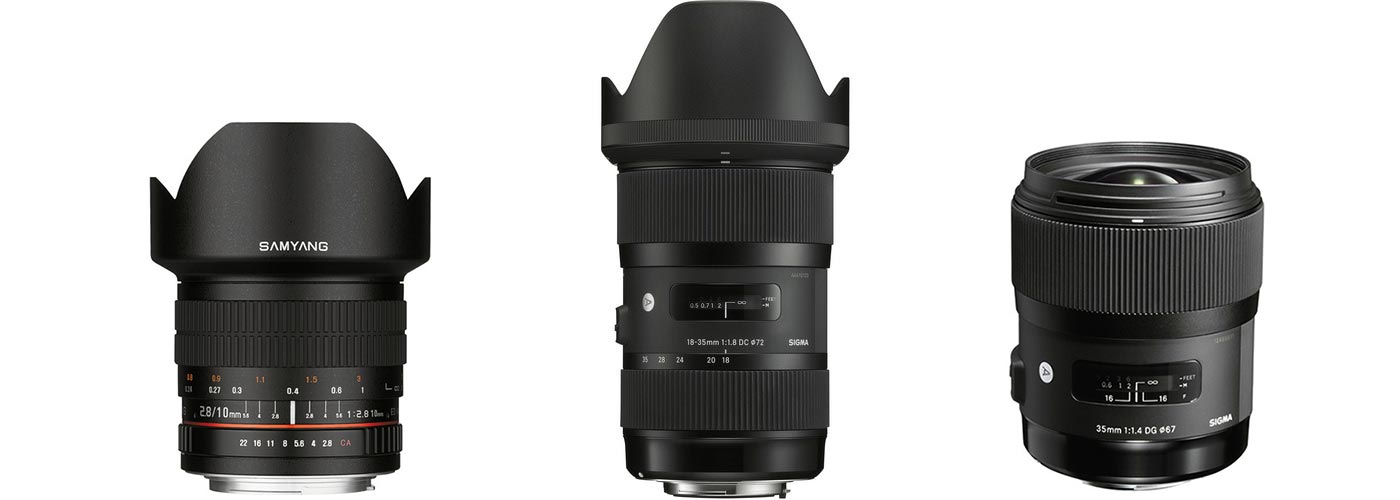
Super Wide Angle: Rokinon 10mm/2.8 (Amazon / B&H)
Fast Wide Angle: Sigma 18-35mm f/1.8 Art (Amazon / B&H)
Budget: Rokinon/Samyang 16mm f/2.0 (Amazon / B&H) or Rokinon/Samyang 20mm f/1.8 (Amazon / B&H)
Standard Prime: Sigma 35mm f/1.4 Art (Amazon / B&H)
Budget: Rokinon/Samyang 35mm f/1.4 (Amazon / B&H)
Pentax offers some of the best value for any DSLR camera system. The Pentax K-3 II comes standard with Astrotracer, an innovative sensor shifting function that allows the camera to automatically track the motion of the stars across the sky as the Earth rotates. This allows the K-3 II to capture the sky as if it were mounted to a tracking equatorial mount making extremely long exposures possible. Rather than being limited to just 15-20 second exposures before the stars start streaking across the frame, the K-3 II can shoot for minutes on end, perfectly tracking the stars. No other manufacturer offers anything remotely similar in their cameras and thus Pentax DSLRs stands alone as some of the most astrophotography capable cameras available. Like Canon and Nikon’s APS-C DSLR offerings, the staple recommendations for fast lenses include the Sigma 18-35mm f/1.8 and Sigma 35mm f/1.4 Art. For a super wide angles, our favorite autofocus Tokina 11-20mm f/2.8 is not available for the K mount so our favorite choice is the affordable manual focus Rokinon 10mm f/2.8.
Pentax K FA Full-Frame
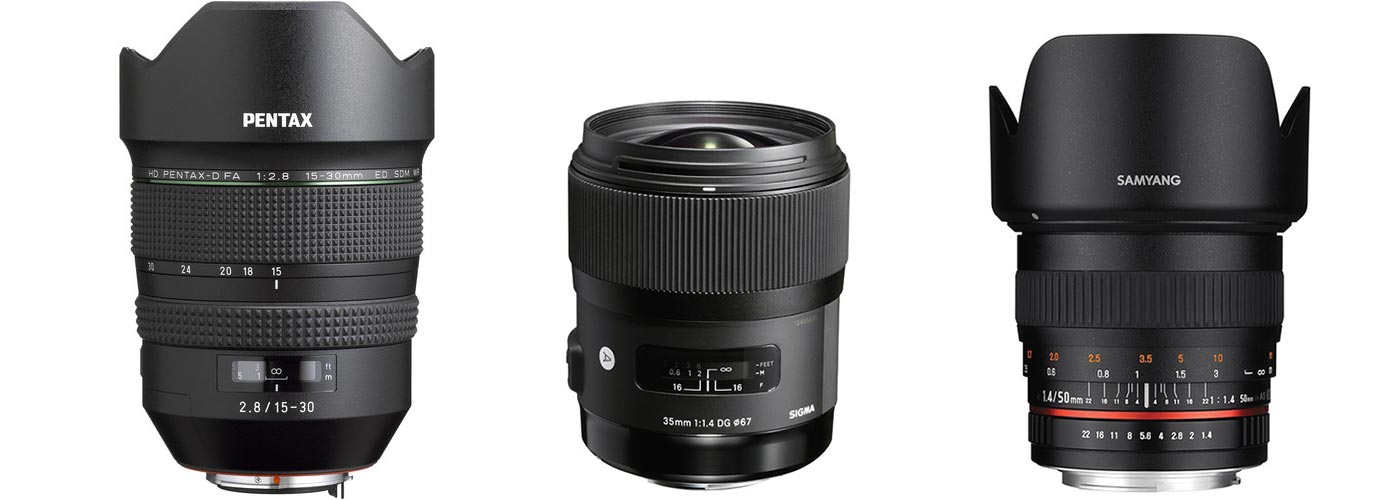
Super Wide Angle: Pentax HD FA 15-30mm f/2.8 ED SDM WR (Amazon / B&H)
Budget: Rokinon/Samyang 14mm f/2.8 (Amazon / B&H) or Rokinon/Samyang 20mm f/1.8 (Amazon / B&H)
Fast Wide Angle: Sigma 35mm f/1.4 Art (Amazon / B&H)
Budget: Rokinon/Samyang 24mm f/1.4 (Amazon / B&H) or 35mm f/1.4 (Amazon / B&H)
Standard Prime: Rokinon/Samyang 50mm f/1.4 (Amazon / B&H)
The Pentax K1 is Pentax’s first full-frame digital camera. Like Pentax’s APS-C DSLRs, the K1 is also equipped with Astrotracer for enabling ultra long, tracked photos of the night sky. The K1 is a very new camera at the time we originally made this list so modern lens choices are limited. Pentax does have the excellent Pentax FA 15-30mm f/2.8 which, as we understand, is a weather sealed and improved version of the excellent Tamron 15-30mm f/2.8. While the Sigma 35mm f/1.4 Art is available for the K1 as our favorite fast wide angle, there are nearly no autofocus standard 50mm primes lenses available for the K mount that we can recommend. Most of Pentax’s native autofocus standard primes leave a lot to be desired in aberration control. That makes the Rokinon 50mm f/1.4 our top choice for a standard prime on the K1.
Olympus and Panasonic Micro 4/3
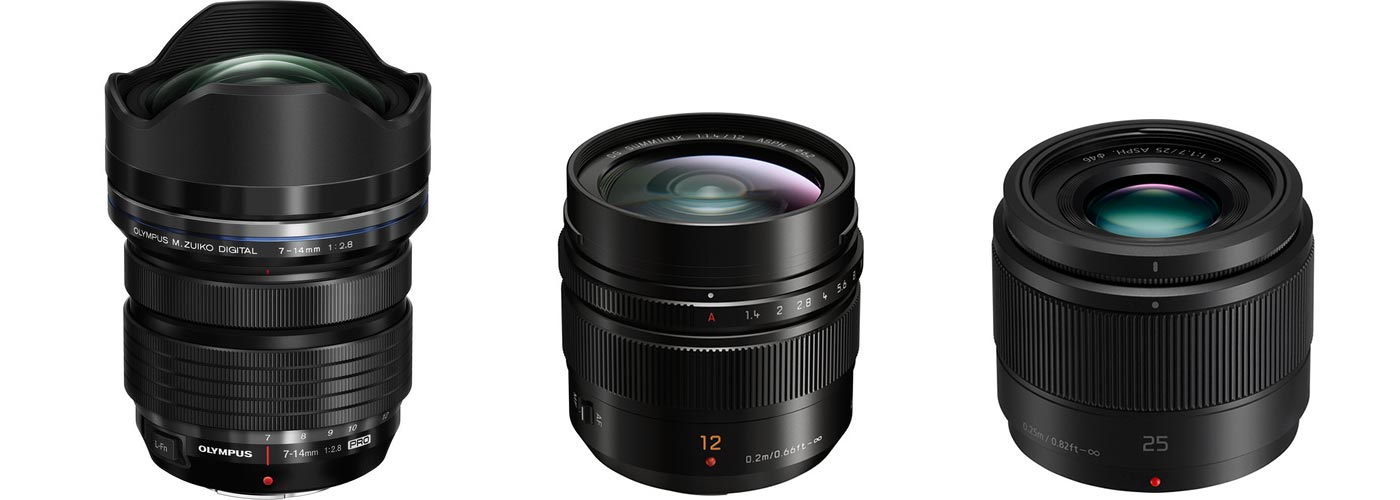
Super Wide Angle: Olympus M.Zuiko Digital 7–14 mm f/2.8 ED PRO (Amazon / B&H) or 8mm f/1.8 ED Pro Fisheye (Amazon / B&H)
Budget: Rokinon 7.5mm f/3.5 Fisheye (Amazon / B&H)
Fast Wide Angle: Panasonic 12mm f/1.4 Summilux (Amazon / B&H)
Budget: Rokinon/Samyang 12mm f/2 (Amazon / B&H)
Standard Prime: Panasonic Lumix G 25 mm f/1.7 ASPH (Amazon / B&H)
Budget: Rokinon/Samyang 21mm f/1.4 (Amazon / B&H)
Olympus and Panasonic both have been making excellent cameras of late and with the combined forces of both manufacturers making lenses for the micro 4/3 mount, there are a ton of lens options. Both of Olympus’s ultra wide angle 7-14mm f/2.8 and 8mm f/2.8 Fisheye are excellent night photography lenses. On the fast prime front, Panasonic offers a Leica designed ultra fast 12mm f/1.4 Summilux, the fastest 12mm lens ever made. The Panasonic 25mm f/1.7 standard prime is also a great choice that has nearly no aberration issues, even when used wide open at f/1.7.
Other Considerations
It’s notable that there are two budget friendly lenses, while not always our first recommendation anymore, are still worth mentioning as they were the lenses that dramatically accelerated the accessibility of astrophotography. Even if they aren’t our first recommendations for any given system, the Rokinon/Samyang branded manual focus 24mm f/1.4 and 14mm f/2.8 (full reviews) lenses are still great cheap options. For full-frame systems, both of these manual focus lenses still offer very good performance for landscape astrophotography at a low price. The manual focus Rokinon 14mm f/2.8 still tops DxO’s list of best ultra-wide angle lenses on the 5DSR and the manual focus Rokinon 24mm f/1.4 shares the top of the DxO’s list of best 24mm lenses for the 5D Mark III. Both of these lenses have stellar coma aberration performance, a common concern for astrophotographers when considering dropping their hard earned cash on new gear.
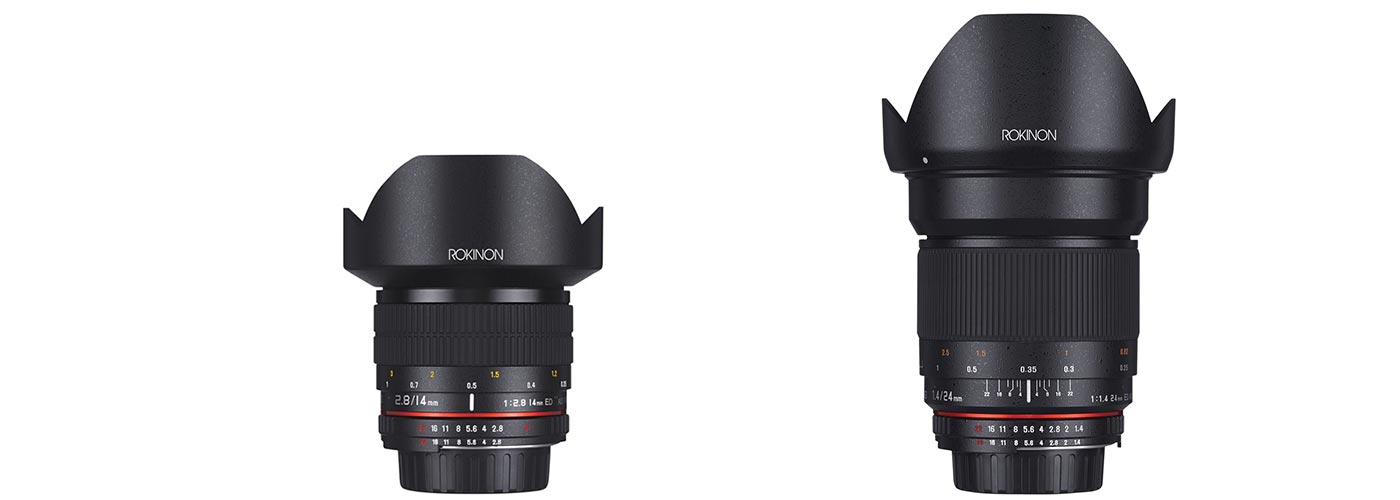
I still whole-heartedly recommend the manual focus Rokinon 14mm f/2.8 and 24mm f/1.4 as two of the best choices for landscape astrophotography, particularly on full-frame cameras, regardless of price. That said, the options have evolved and there are now many more options available for any given system, as we’ve shown below.
Closing Remarks
There are many other lens options that may also be great choices but these are our favorites. One of the most important traits, with few exceptions, is that the lenses on this page are generally spectacular in regards to minimizing aberration like astigmatism and coma that would affect stars on the corner of the frame. There may be some lenses that I have not listed here but that does not mean that the may be a great choice, too. Is there a lens that you use and love for astrophotography? Share it in the comments below!
I’ll be keeping this gear guide up to date as we review and test more lenses across the various camera systems.
Disclosure
We are a participant in the Amazon Services LLC Associates Program, an affiliate advertising program designed to provide a means for us to earn fees by linking to Amazon.com and affiliated sites. We are also a participant in the B&H Affiliate Program which also allows us to earn fees by linking to bhphotovideo.com.
Learn Astrophotography
Astrophotography 101 is completely free for everyone. All of the lessons are available on the Lonely Speck Astrophotography 101 page for you to access at any time. Enter your email and whenever we post a new lesson you’ll receive it in your inbox. We won’t spam you and your email will stay secure. Furthermore, updates will be sent out only periodically, usually less than once per week.
Help us help you!
Believe it or not, Lonely Speck is my full-time job. It’s been an amazing experience for us to see a community develop around learning astrophotography and we’re so happy to be a small part of it. I have learned that amazing things happen when you ask for help so remember that we are always here for you. If you have any questions about photography or just want to share a story, contact us! If you find the articles here helpful, consider helping us out with a donation.
[button font_size=”16″ color=”#136e9f” text_color=”#ffffff” url=”https://www.paypal.com/cgi-bin/webscr?cmd=_donations&business=lonelyspeckblog%40gmail.com&item_name=These+tips+help+keep+lonelyspeck.com+running.¤cy_code=USD&source=url” target=”_blank”]Donate[/button]
Thanks so much for being a part of our astrophotography adventure.
-Ian
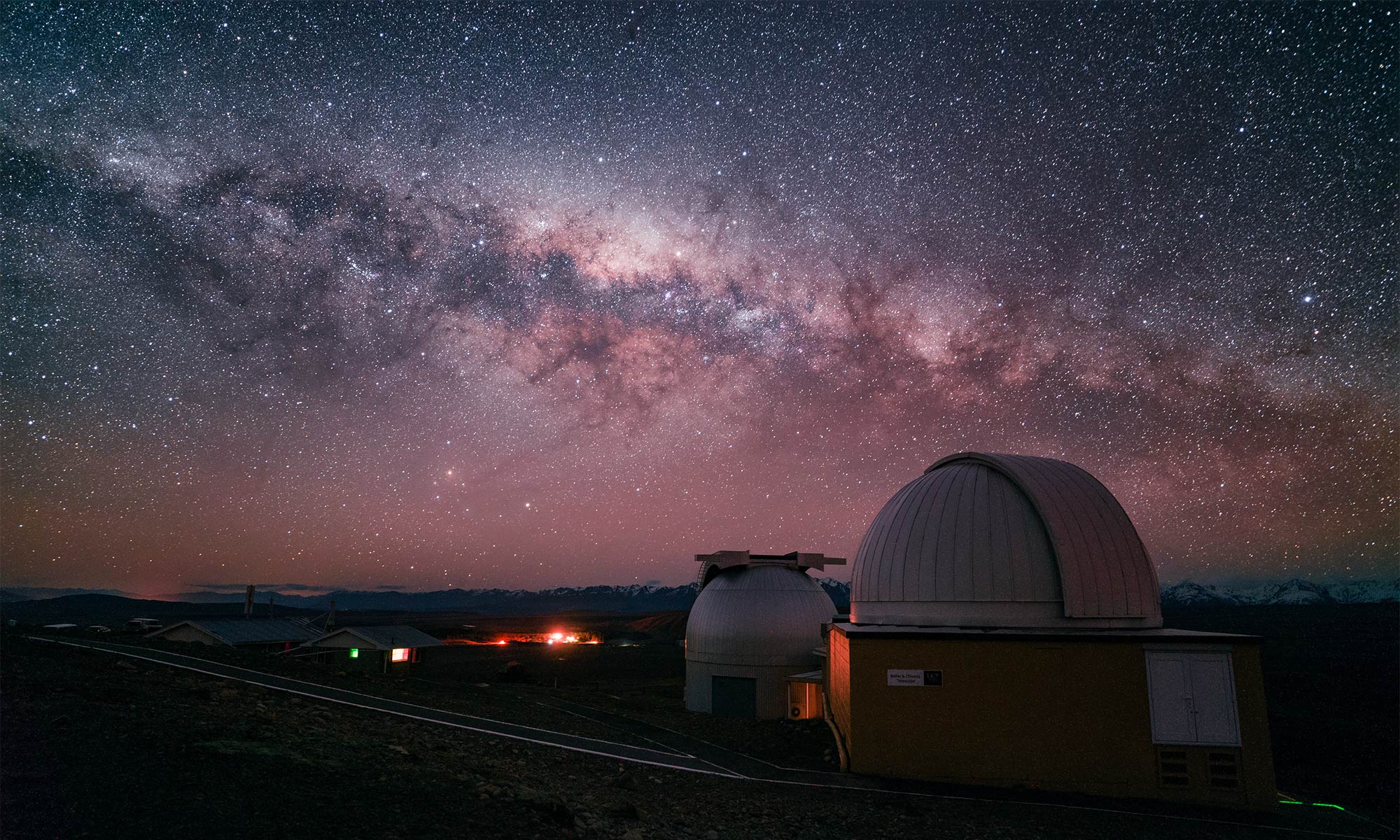
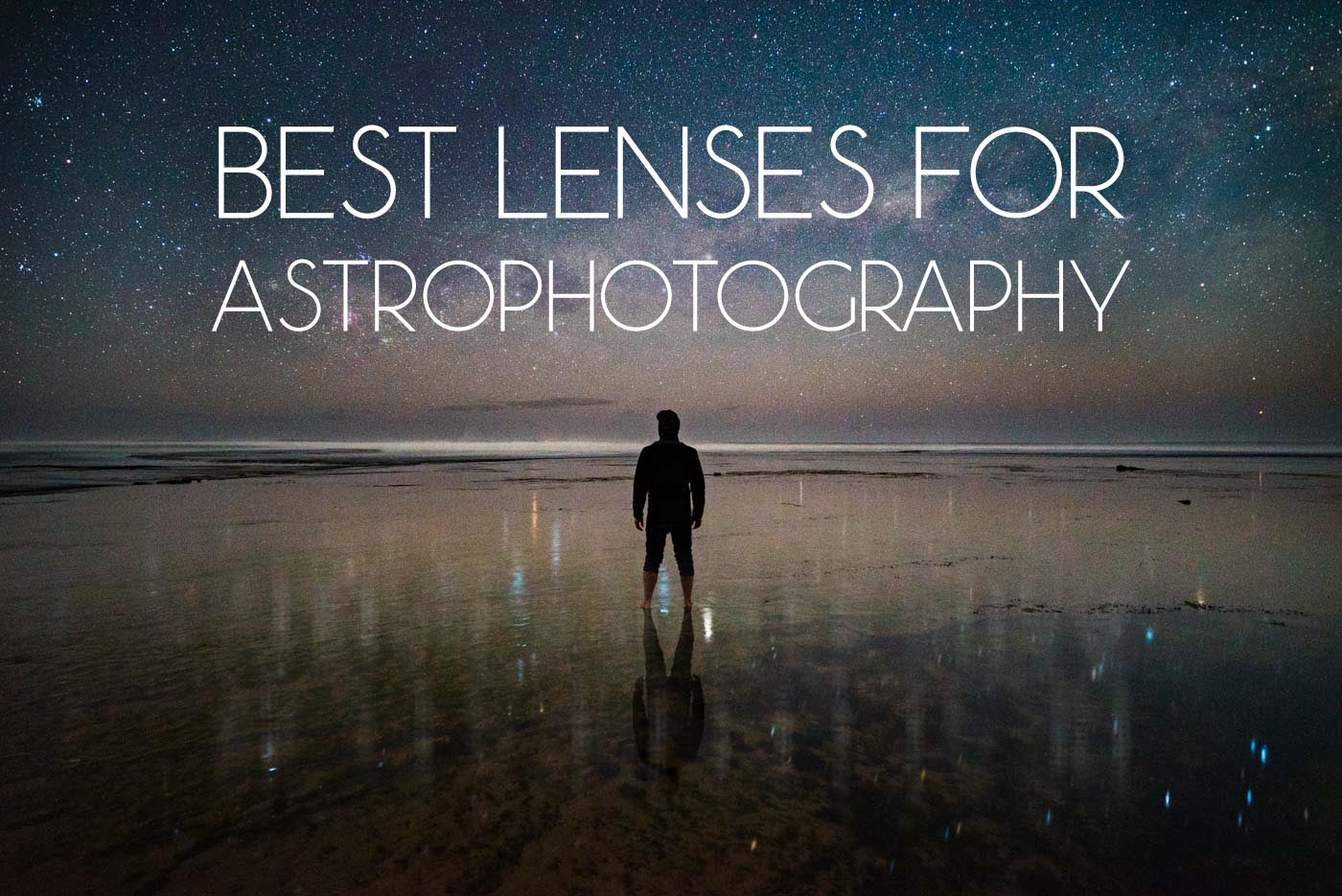
I am genuinely happy that i found this post. Great job on the article.
Hi ! would you recommend the Sigma 20mm f2 as much as the Sony 20mm f1.8 please ? It seems to be an interesting lens too, but the choice is tough !
Pretty new to astrophotography so this article helped me a lot. Thanks very much.
This is a wonderful article full of resources. You described it very well. Thanks for sharing this with us.